1.jdbc的概述
持久化:把数据保存到可掉电式存储设备中以供之后使用.
JDBC (Java Database Connectivity)是一个独立于特定数据库管理系统、通用的SQL数据库存取和操作的公共接口(一组API),是SUN提供的一套 API,使用这套API可以实现对具体数据库的操作(获取连接、关闭连接、DML、DDL、DCL)
JDBC,是SUN提供的一套 API,使用这套API可以实现对具体数据库的操作(获取连接、关闭连接、DML、DDL、DCL)

好处:
从开发程序员的角度:不需要关注具体的数据库的细节
数据库厂商:只需要提供标准的具体实现。
2.数据库的连接(使用类的加载器读取配置文件)
public static Connection getConnection() throws Exception {
// 1.读取配置文件中的4个基本信息
InputStream is = ClassLoader.getSystemClassLoader().getResourceAsStream("jdbc.properties");
Properties pros = new Properties();
pros.load(is);
String user = pros.getProperty("user");
String password = pros.getProperty("password");
String url = pros.getProperty("url");
String driverClass = pros.getProperty("driverClass");
// 2.加载驱动 mysql可以省略
Class.forName(driverClass);
// 3.获取连接
Connection conn = DriverManager.getConnection(url, user, password);
return conn;
}
其中,配置文件【jdbc.properties】:此配置文件声明在工程的src下
user=root
password=abc123
url=jdbc:mysql://localhost:3306/test?rewriteBatchedStatements=true
driverClass=com.mysql.jdbc.Driver
3.PreparedStatement的使用[不考虑泛型]
① PreparedStatement 是Statement的子接口
② 预编译的sql语句
③ 可以解决Statement的sql注入问题,拼串问题
3.1通用的增删改操作
public void update(String sql,Object ...args){//sql中占位符的个数与可变形参的长度相同!
Connection conn = null;
PreparedStatement ps = null;
try {
//1.获取数据库的连接
conn = JDBCUtils.getConnection();
//2.预编译sql语句,返回PreparedStatement的实例
ps = conn.prepareStatement(sql);
//3.填充占位符
for(int i = 0;i < args.length;i++){
ps.setObject(i + 1, args[i]);//小心参数声明错误!!
}
//4.执行
ps.execute();
} catch (Exception e) {
e.printStackTrace();
}finally{
//5.资源的关闭
JDBCUtils.closeResource(conn, ps);
}
}
3.2通用的查询
利用结果集的 rs.getMetaData()获取元数据rsmd ,后通过getColumnLabel,getColumnCount分别获得名称和列数
public <T> T getInstance(Class<T> clazz,String sql, Object... args) {
Connection conn = null;
PreparedStatement ps = null;
ResultSet rs = null;
try {
conn = JDBCUtils.getConnection();
ps = conn.prepareStatement(sql);
for (int i = 0; i < args.length; i++) {
ps.setObject(i + 1, args[i]);
}
rs = ps.executeQuery();
// 获取结果集的元数据 :ResultSetMetaData
ResultSetMetaData rsmd = rs.getMetaData();
// 通过ResultSetMetaData获取结果集中的列数
int columnCount = rsmd.getColumnCount();
if (rs.next()) {
T t = clazz.newInstance();
// 处理结果集一行数据中的每一个列
for (int i = 0; i < columnCount; i++) {
// 获取列值
Object columValue = rs.getObject(i + 1);
// 获取每个列的列名
String columnLabel = rsmd.getColumnLabel(i + 1);
// 给t对象指定的columnName属性,赋值为columValue:通过反射
Field field = clazz.getDeclaredField(columnLabel);
field.setAccessible(true);
field.set(t, columValue);
}
return t;
}
} catch (Exception e) {
e.printStackTrace();
} finally {
JDBCUtils.closeResource(conn, ps, rs);
}
return null;
}
返回多个对象:
public <T> List<T> getForList(Class<T> clazz,String sql, Object... args){
Connection conn = null;
PreparedStatement ps = null;
ResultSet rs = null;
try {
conn = JDBCUtils.getConnection();
ps = conn.prepareStatement(sql);
for (int i = 0; i < args.length; i++) {
ps.setObject(i + 1, args[i]);
}
rs = ps.executeQuery();
// 获取结果集的元数据 :ResultSetMetaData
ResultSetMetaData rsmd = rs.getMetaData();
// 通过ResultSetMetaData获取结果集中的列数
int columnCount = rsmd.getColumnCount();
//创建集合对象
ArrayList<T> list = new ArrayList<T>();
while (rs.next()) {
T t = clazz.newInstance();
// 处理结果集一行数据中的每一个列:给t对象指定的属性赋值
for (int i = 0; i < columnCount; i++) {
// 获取列值
Object columValue = rs.getObject(i + 1);
// 获取每个列的列名
// String columnName = rsmd.getColumnName(i + 1);
String columnLabel = rsmd.getColumnLabel(i + 1);
// 给t对象指定的columnName属性,赋值为columValue:通过反射
Field field = clazz.getDeclaredField(columnLabel);
field.setAccessible(true);
field.set(t, columValue);
}
list.add(t);
}
return list;
} catch (Exception e) {
e.printStackTrace();
} finally {
JDBCUtils.closeResource(conn, ps, rs);
}
return null;
}
面向接口编程的思想
ORM编程思想:(object relational mapping)
- 一个数据表对应一个java类
- 表中的一条记录对应java类的一个对象
- 表中的一个字段对应java类的一个属性
1.使用结果集的元数据:ResultSetMetaData
getColumnCount():获取列数
getColumnLabel():获取列的别名
说明:如果sql中没给字段其别名,getColumnLabel()获取的就是列名
- 反射的使用(①创建对应的运行时类的对象 ② 在运行时,动态的调用指定的运行时类的属性、方法)
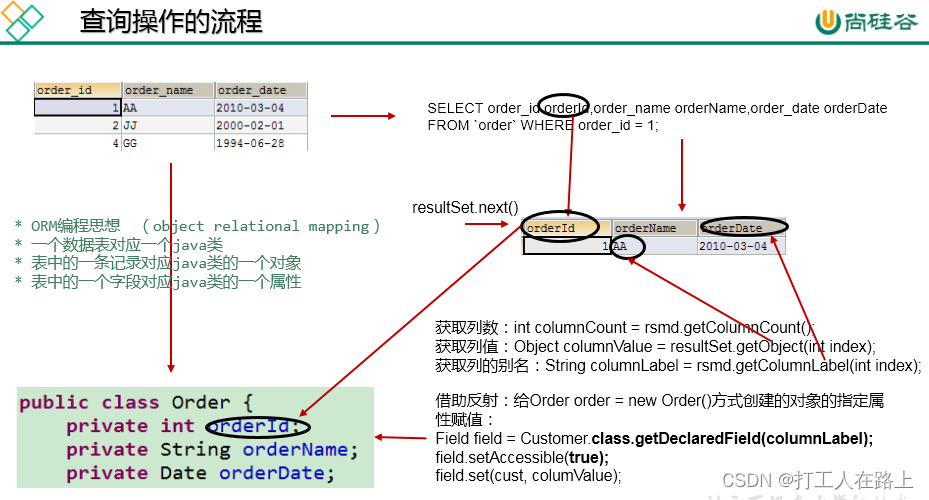
4.操作Blob类型的变量
写入操作的方法:setBlob(InputStream is);
读取操作的方法:
Blob blob = getBlob(int index);
InputStream is = blob.getBinaryStream();
区别于: FileInputStream is = new FileInputStream(new File(“girl.jpg”)); ps.setBlob(4, is);
//将Blob类型的字段下载下来,以文件的方式保存在本地
Blob photo = rs.getBlob("photo");
is = photo.getBinaryStream();
fos = new FileOutputStream("zhangyuhao.jpg");
byte[] buffer = new byte[1024];
int len;
while((len = is.read(buffer)) != -1){
fos.write(buffer, 0, len);
}

5.批量操作
1.先设置自动提交(flase) , addBatch()、executeBatch()、clearBatch()
2.mysql服务器默认关闭批处理的,设置**?rewriteBatchedStatements=true** 写在配置文件的url后面
public void testInsert3() {
Connection conn = null;
PreparedStatement ps = null;
try {
conn = JDBCUtils.getConnection();
//设置不允许自动提交数据
conn.setAutoCommit(false);
String sql = "insert into goods(name)values(?)";
ps = conn.prepareStatement(sql);
for(int i = 1;i <= 1000000;i++){
ps.setObject(1, "name_" + i);
ps.addBatch();//1."攒"sql
if(i % 500 == 0){
ps.executeBatch();//2.执行batch
ps.clearBatch();//3.清空batch
}
}
conn.commit();//提交数据
} catch (Exception e) { //1000000:16086 -- 5114
e.printStackTrace();
}finally{
JDBCUtils.closeResource(conn, ps);
}
}
总结:PreparedStatement与Statement的异同?
① 指出二者的关系? 接口 与 子接口的关系
② 开发中,PreparedStatement替换Statement
③ An object that represents a precompiled SQL statement.

6.数据库的事务(ACID)
四大属性: A 原子性 C一致性 I隔离性 D持久性
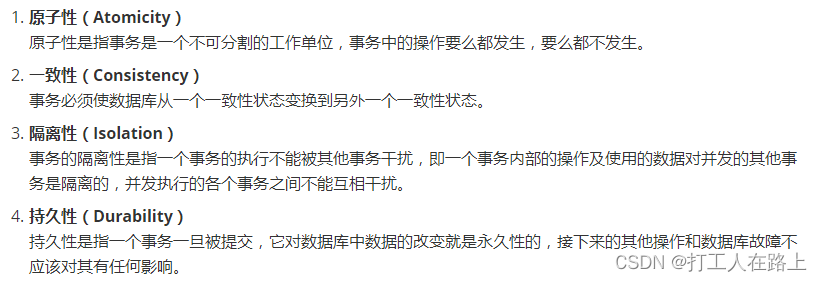
数据操作过程中可能出现的问题:(针对隔离性)

数据库的四种隔离级别:(一致性和并发性:一致性越好,并发性越差)


查看隔离的级别:
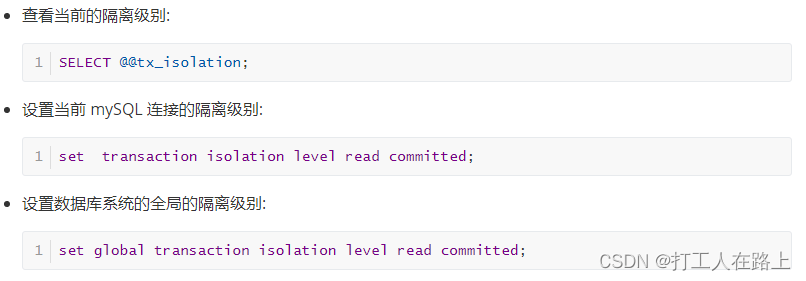
1.事务:一组逻辑操作单元,使数据从一种状态变换到另一种状态。
-
> 一组逻辑操作单元:一个或多个DML操作。
2.事务处理的原则:
保证所事务都作为一个工作单元来执行,即使出现了故障**,都不能改变这种执行方式。**
当在一个事务中执行多个操作时,要么所有的事务都被提交(commit),那么这些修改就永久地保存下来;要么数据库管理系统将放弃所作的所有修改,整个事务回滚(rollback)到最初状态。
注意:
1.数据一旦提交,就不可回滚
- DDL操作一旦执行,都会自动提交。 set autocommit = false 对DDL操作失效
- DML默认情况下,一旦执行,就会自动提交。通过set autocommit = false的方式取消DML操作的自动提交。
- 默认在关闭连接时,会自动的提交数据
方法:先设置setAutoCommit(false)>执行完conn.commit()>catch中 conn,rollback()
public void testUpdateWithTx() {
Connection conn = null;
try {
conn = JDBCUtils.getConnection();
conn.setAutoCommit(false);//1.取消数据的自动提交
String sql1 = "update user_table set balance = balance - 100 where user = ?";
update(conn,sql1, "AA");
System.out.println(10 / 0);
String sql2 = "update user_table set balance = balance + 100 where user = ?";
update(conn,sql2, "BB");
conn.commit();//2.提交数据
} catch (Exception e) {
e.printStackTrace();
//3.回滚数据
try {
conn.rollback();
} catch (SQLException e1) {
e1.printStackTrace();
}
}finally{
try {
conn.setAutoCommit(true); //主要针对于使用数据库连接池的使用,修改其为自动提交数据
} catch (SQLException e) {
e.printStackTrace();
}
JDBCUtils.closeResource(conn, null);
}
}
通用的查询
/通用的查询操作,用于返回数据表中的一条记录(version 2.0:考虑上事务)
public <T> T getInstance(Connection conn,Class<T> clazz,String sql, Object... args) {
PreparedStatement ps = null;
ResultSet rs = null;
try {
ps = conn.prepareStatement(sql);
for (int i = 0; i < args.length; i++) {
ps.setObject(i + 1, args[i]);
}
rs = ps.executeQuery();
// 获取结果集的元数据 :ResultSetMetaData
ResultSetMetaData rsmd = rs.getMetaData();
// 通过ResultSetMetaData获取结果集中的列数
int columnCount = rsmd.getColumnCount();
if (rs.next()) {
T t = clazz.newInstance();
// 处理结果集一行数据中的每一个列
for (int i = 0; i < columnCount; i++) {
// 获取列值
Object columValue = rs.getObject(i + 1);
// 获取每个列的列名
// String columnName = rsmd.getColumnName(i + 1);
String columnLabel = rsmd.getColumnLabel(i + 1);
// 给t对象指定的columnName属性,赋值为columValue:通过反射
Field field = clazz.getDeclaredField(columnLabel);
field.setAccessible(true);
field.set(t, columValue);
}
return t;
}
} catch (Exception e) {
e.printStackTrace();
} finally {
JDBCUtils.closeResource(null, ps, rs);
}
return null;
}
7.获取父类的泛型参数
private Class<T> clazz = null;
{
//获取当前BaseDAO的子类继承的父类中的泛型
Type genericSuperclass = this.getClass().getGenericSuperclass();
ParameterizedType paramType = (ParameterizedType) genericSuperclass;
Type[] typeArguments = paramType.getActualTypeArguments();//获取了父类的泛型参数
clazz = (Class<T>) typeArguments[0];//泛型的第一个参数
}
通用的增删改操作(考虑泛型和事务)
// 通用的增删改操作---version 2.0 (考虑上事务
public int update(Connection conn, String sql, Object... args) {// sql中占位符的个数与可变形参的长度相同!
PreparedStatement ps = null;
try {
// 1.预编译sql语句,返回PreparedStatement的实例
ps = conn.prepareStatement(sql);
// 2.填充占位符
for (int i = 0; i < args.length; i++) {
ps.setObject(i + 1, args[i]);// 小心参数声明错误!!
}
// 3.执行
return ps.executeUpdate();
} catch (Exception e) {
e.printStackTrace();
} finally {
// 4.资源的关闭
JDBCUtils.closeResource(null, ps);
}
return 0;
}
// 通用的查询操作,用于返回数据表中的一条记录(version 2.0:考虑上事务
public T getInstance(Connection conn, String sql, Object... args) {
PreparedStatement ps = null;
ResultSet rs = null;
try {
ps = conn.prepareStatement(sql);
for (int i = 0; i < args.length; i++) {
ps.setObject(i + 1, args[i]);
}
rs = ps.executeQuery();
// 获取结果集的元数据 :ResultSetMetaData
ResultSetMetaData rsmd = rs.getMetaData();
// 通过ResultSetMetaData获取结果集中的列数
int columnCount = rsmd.getColumnCount();
if (rs.next()) {
T t = clazz.newInstance();
// 处理结果集一行数据中的每一个列
for (int i = 0; i < columnCount; i++) {
// 获取列值
Object columValue = rs.getObject(i + 1);
// 获取每个列的列名
// String columnName = rsmd.getColumnName(i + 1);
String columnLabel = rsmd.getColumnLabel(i + 1);
// 给t对象指定的columnName属性,赋值为columValue:通过反射
Field field = clazz.getDeclaredField(columnLabel);
field.setAccessible(true);
field.set(t, columValue);
}
return t;
}
} catch (Exception e) {
e.printStackTrace();
} finally {
JDBCUtils.closeResource(null, ps, rs);
}
return null;
}
// 通用的查询操作,用于返回数据表中的多条记录构成的集合(version 2.0:考虑上事务
public List<T> getForList(Connection conn, String sql, Object... args) {
PreparedStatement ps = null;
ResultSet rs = null;
try {
ps = conn.prepareStatement(sql);
for (int i = 0; i < args.length; i++) {
ps.setObject(i + 1, args[i]);
}
rs = ps.executeQuery();
// 获取结果集的元数据 :ResultSetMetaData
ResultSetMetaData rsmd = rs.getMetaData();
// 通过ResultSetMetaData获取结果集中的列数
int columnCount = rsmd.getColumnCount();
// 创建集合对象
ArrayList<T> list = new ArrayList<T>();
while (rs.next()) {
T t = clazz.newInstance();
// 处理结果集一行数据中的每一个列:给t对象指定的属性赋值
for (int i = 0; i < columnCount; i++) {
// 获取列值
Object columValue = rs.getObject(i + 1);
// 获取每个列的列名
// String columnName = rsmd.getColumnName(i + 1);
String columnLabel = rsmd.getColumnLabel(i + 1);
// 给t对象指定的columnName属性,赋值为columValue:通过反射
Field field = clazz.getDeclaredField(columnLabel);
field.setAccessible(true);
field.set(t, columValue);
}
list.add(t);
}
return list;
} catch (Exception e) {
e.printStackTrace();
} finally {
JDBCUtils.closeResource(null, ps, rs);
}
return null;
}
//用于查询特殊值的通用的方法
public <E> E getValue(Connection conn,String sql,Object...args){
PreparedStatement ps = null;
ResultSet rs = null;
try {
ps = conn.prepareStatement(sql);
for(int i = 0;i < args.length;i++){
ps.setObject(i + 1, args[i]);
}
rs = ps.executeQuery();
if(rs.next()){
return (E) rs.getObject(1);
}
} catch (SQLException e) {
e.printStackTrace();
}finally{
JDBCUtils.closeResource(null, ps, rs);
}
return null;
}
}
7.数据库连接池
1.传统连接的问题:
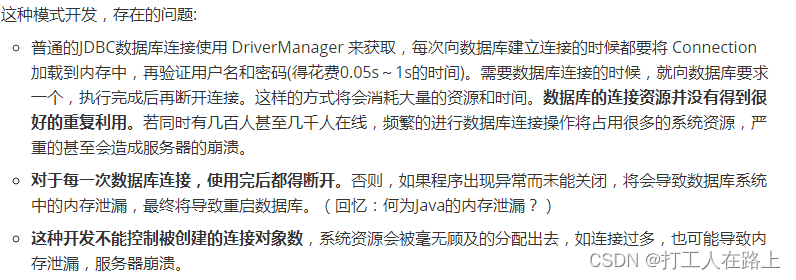
2.如何解决传统开发中的数据库连接问题:使用数据库连接池
3.使用数据库连接池的好处:
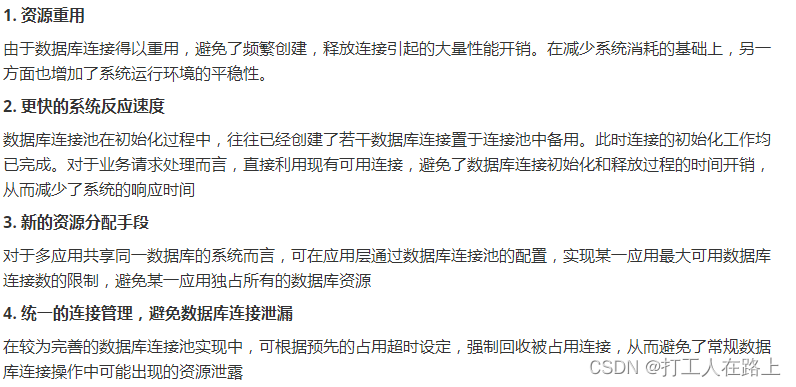
或自己组织语言:
1.提高程序的响应速度(减少了创建连接相应的时间)
2.降低资源的消耗(可以重复使用已经提供好的连接)
3.便于连接的管理
4.实现的方式:

8.c3p0使用
//数据库连接池只需提供一个即可。
private static ComboPooledDataSource cpds = new ComboPooledDataSource("hellc3p0");
public static Connection getConnection1() throws SQLException{
Connection conn = cpds.getConnection();
return conn;
}
其中,配置文件定义在src下。名为:c3p0-config.xml
<?xml version="1.0" encoding="UTF-8"?>
<c3p0-config>
<named-config name="hellc3p0">
<!-- 提供获取连接的4个基本信息 -->
<property name="driverClass">com.mysql.jdbc.Driver</property>
<property name="jdbcUrl">jdbc:mysql:///test</property>
<property name="user">root</property>
<property name="password">abc123</property>
<!-- 进行数据库连接池管理的基本信息 -->
<!-- 当数据库连接池中的连接数不够时,c3p0一次性向数据库服务器申请的连接数 -->
<property name="acquireIncrement">5</property>
<!-- c3p0数据库连接池中初始化时的连接数 -->
<property name="initialPoolSize">10</property>
<!-- c3p0数据库连接池维护的最少连接数 -->
<property name="minPoolSize">10</property>
<!-- c3p0数据库连接池维护的最多的连接数 -->
<property name="maxPoolSize">100</property>
<!-- c3p0数据库连接池最多维护的Statement的个数 -->
<property name="maxStatements">50</property>
<!-- 每个连接中可以最多使用的Statement的个数 -->
<property name="maxStatementsPerConnection">2</property>
</named-config>
</c3p0-config>
9.DBCP
//创建一个DBCP数据库连接池
private static DataSource source;
static{
try {
Properties pros = new Properties();
FileInputStream is = new FileInputStream(new File("src/dbcp.properties"));
pros.load(is);
source = BasicDataSourceFactory.createDataSource(pros);
} catch (Exception e) {
e.printStackTrace();
}
}
public static Connection getConnection2() throws Exception{
Connection conn = source.getConnection();
return conn;
}
其中,配置文件定义在src下:dbcp.properties
driverClassName=com.mysql.jdbc.Driver
url=jdbc:mysql:///test
username=root
password=abc123
initialSize=10
10.durid
private static DataSource source1;
static{
try {
Properties pros = new Properties();
InputStream is = ClassLoader.getSystemClassLoader().getResourceAsStream("druid.properties");
pros.load(is);
source1 = DruidDataSourceFactory.createDataSource(pros);
} catch (Exception e) {
e.printStackTrace();
}
}
public static Connection getConnection3() throws SQLException{
Connection conn = source1.getConnection();
return conn;
}
其中,配置文件定义在src下:druid.properties
url=jdbc:mysql:///test
username=root
password=abc123
driverClassName=com.mysql.jdbc.Driver
initialSize=10
maxActive=10






















 318
318











 被折叠的 条评论
为什么被折叠?
被折叠的 条评论
为什么被折叠?








